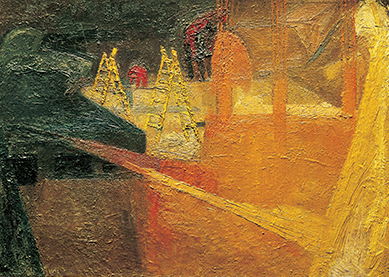Frank Auerbach was evacuated from Berlin to England in 1939, as the Nazis’ persecution of the Jews spiralled into genocide. He was seven years old at the time. He was sent to boarding school, first in Kent and then on the Welsh Borders. He was still an evacuee schoolboy when he discovered that both his parents had lost their lives in a concentration camp. After the war was over, Auerbach settled in London. He studied painting first at the Hampstead Garden Suburb Institute and then at the Borough Polytechnic, where his teachers included the inspirational David Bomberg. Bomberg had been a leading light of the Vorticist movement in the years before the First World War, but by the late 1940s he had abandoned the juddering abstractions of his youth to work in a richly expressive figurative style. Bomberg painted the landscapes of Palestine and Spain and the cityscapes of war-torn London, seeking not exact representational truth but something more nebulous and personal – “the spirit in the mass” was his mantra.
The young Auerbach was deeply impressed, both by Bomberg’s work and by his teaching. After completing his education at St Martin’s School of Art and then the Royal College, he embarked on his own career as an artist. By 1954, he had his own studio in Camden Town. He has been there ever since, painting the city, painting portraits of his friends, painting the gentle arc of Primrose Hill against the sullen London sky, with a fiercely productive energy that has now lasted more than half a century. At the age of seventy eight he is still going strong. At his best, he is an artist of immense power and seriousness, heir not only to his first mentor, Bomberg, but also to John Constable, that passionate, stubborn, uncompromisingly radical...
The young Auerbach was deeply impressed, both by Bomberg’s work and by his teaching. After completing his education at St Martin’s School of Art and then the Royal College, he embarked on his own career as an artist. By 1954, he had his own studio in Camden Town. He has been there ever since, painting the city, painting portraits of his friends, painting the gentle arc of Primrose Hill against the sullen London sky, with a fiercely productive energy that has now lasted more than half a century. At the age of seventy eight he is still going strong. At his best, he is an artist of immense power and seriousness, heir not only to his first mentor, Bomberg, but also to John Constable, that passionate, stubborn, uncompromisingly radical...


